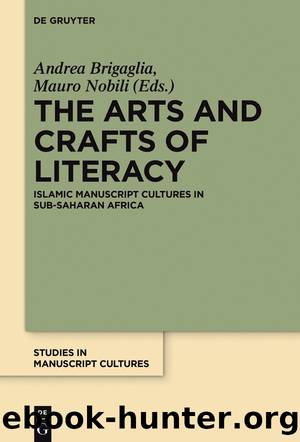The Arts and Crafts of Literacy by Andrea Brigaglia Mauro Nobili

Author:Andrea Brigaglia, Mauro Nobili [Andrea Brigaglia, Mauro Nobili]
Language: eng
Format: epub
ISBN: 9783110541403
Google: eSw5xQEACAAJ
Barnesnoble:
Publisher: De Gruyter
Published: 2017-09-11T00:00:00+00:00
3Authorâs biography
Almamyâs handwritten copies of the Bamana texts were accompanied by several notes, written by him in French, explaining their provenance. These include statements about the identities of the author and the owner of the manuscripts, as well as the alleged date and reasons for composition. Both Almamy, with whom I discussed these texts in Bamako in 1992, and Bory Bary, whom I first met in San in 1998, confirmed that the latter was the source of information for these notes.
Almamyâs French notes clearly imply that a certain âAmadou Baryâ was the author of the texts.358 However, when I discussed them with him in 1992, Almamy was not so sure; he suggested that Amadou Bary may have merely copied or collected the texts. However, Bory Bary, both in 1998 and on several subsequent occasions, confirmed that his father had written the texts.
This claim is supported by additional evidence. Bory Bary confirms that his father spoke Bamana. Furthermore, the texts include several locutions that suggest they were written by a non-native speaker. In two instances, the relationship between a living being and a part of its body is indicated by the particle ka (which normally marks alienable possession) rather than by the zero marker, indicating inalienable possession. Thus, text II, line 10, reads i k tonna, which I interpret as i ka tÉn na (âthe nape of your neckâ), whereas a more typical formulation, by a native speaker, would be simply i tÉn na. Similarly, an invocation addressed to a tree reads mÄ«n bii ka bulÅ«wla (V.7), that is min bâi ka buluw la (âwhich are in your leavesâ), whereas a native speaker would typically say i buluw. Furthermore, the name of Sanâs famous, permanent-water lake is given as Sankeer(e) (I.11 and I.13), whereas its name is normally pronounced Sanke or Sange by the Bamana-speaking inhabitants of San. Since -re is the Fulfulde locative suffix, this specifically suggests that the writer was a Fulfulde-speaker. There are two other atypical formulations in these texts (III.7, IV.4 â see more below), but in these instances, it is difficult to know whether one is dealing with unidiomatic expression by a non-native speaker, errors by the copyist, or even language change. Thus, there is no longer any reason to doubt that Amadou Bary, father of Bory, was the author of these texts.
The other major piece of information contained in Almamyâs notes concerns the date of composition of these texts â indicated as the year â1911â. When I met them, neither Almamy nor Bory Bary could explain this date, which was presumably based either on a note associated with the texts (but then, why wasnât it copied?), or on that of another document found near them, or on oral information transmitted by Bory Bary. The precision of this date contrasts awkwardly with the otherwise limited information Almamy and Bory possessed about these manuscripts, whom the latter found by rummaging through his fatherâs belongings.359 It is also curious that â if written by Boryâs father â this date would have been expressed in the Gregorian calendar only (omitting the hijri year).
Download
This site does not store any files on its server. We only index and link to content provided by other sites. Please contact the content providers to delete copyright contents if any and email us, we'll remove relevant links or contents immediately.
How to Be a Bawse: A Guide to Conquering Life by Lilly Singh(7360)
Spare by Prince Harry The Duke of Sussex(5053)
Millionaire: The Philanderer, Gambler, and Duelist Who Invented Modern Finance by Janet Gleeson(4352)
Machine Learning at Scale with H2O by Gregory Keys | David Whiting(4103)
Never by Ken Follett(3761)
Harry Potter 02 & The Chamber Of Secrets (Illustrated) by J.K. Rowling(3612)
The Heroin Diaries by Nikki Sixx(3478)
Urban Outlaw by Magnus Walker(3322)
Harry Potter and the Prisoner of Azkaban (Book 3) by J. K. Rowling(3292)
Fairy Tale by Stephen King(3192)
Japanese Design by Patricia J. Graham(3095)
The Man Who Died Twice by Richard Osman(2977)
The Club by A.L. Brooks(2851)
Stacked Decks by The Rotenberg Collection(2795)
Will by Will Smith(2769)
Harry Potter and the Deathly Hallows (7) by J.K. Rowling(2629)
Churchill by Paul Johnson(2493)
The Chimp Paradox by Peters Dr Steve(2279)
Borders by unknow(2213)
